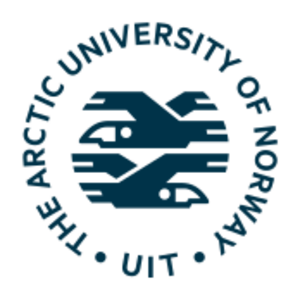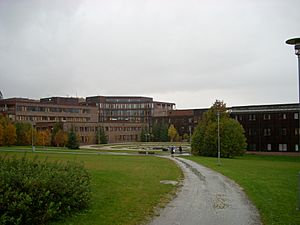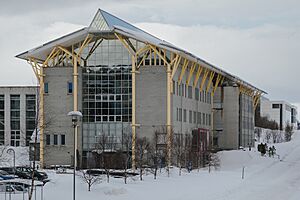The Arctic University of Norway facts for kids
|
UiT Norges arktiske universitet (Bokmål)
UiT Noregs arktiske universitet (Nynorsk) UiT Norgga árktalaš universitehta (Northern Sami) |
|

Seal
|
|
| Motto |
Drivkraft i nord
|
|---|---|
|
Motto in English
|
Driving force in the North |
| Type | Public University |
| Established | 1968 |
| Chair | Marianne Elisabeth Johnsen |
| Rector | Dag Rune Olsen |
|
Total staff
|
3776 (2021) |
| Students | 16,204 (2024) |
| Location |
Tromsø, Alta, Hammerfest, Harstad and Narvik
,
|
| Campus | Multiple sites |
| Affiliations | EUA, UArctic, YERUN, EUGLOH |
| Website | www.uit.no |
 |
|
The University of Tromsø – The Arctic University of Norway is a big public university in Norway. It is known as the world's northernmost university. It first opened in 1972 in the city of Tromsø.
Today, it is the largest place for learning and research in Northern Norway. It is also the eighth-largest university in all of Norway. Because it is so far north, it is a great place to study the Arctic's nature, people, and culture.
The university focuses on many interesting subjects. These include Northern Lights research and space science. They also study fish and oceans, biotechnology, and linguistics (the study of language). Other important areas are mathematics, different cultures, and the Sami culture. They also work on telemedicine (healthcare from a distance) and Arctic research.
The university is close to other important research centers. These include the Norwegian Polar Institute and the Norwegian Institute of Marine Research. This makes Tromsø a key place for Arctic studies around the world.
Contents
History of UiT
How UiT Grew Through Mergers
UiT has grown by joining with other colleges. On January 1, 2009, it merged with Tromsø University College. This added teacher education to the university.
Then, on August 1, 2013, it joined with Finnmark University College. This created the new name: Universitetet i Tromsø – Norges arktiske universitet. This merger also added campuses in Alta, Hammerfest, and Kirkenes.
Later, on January 1, 2016, Narvik University College and Harstad University College also joined UiT. Now, UiT has eleven campus locations across northern Norway. The main campus is still in Tromsø.
A Guest Researcher Incident in 2022
In October 2022, a guest researcher at UiT was arrested. He was suspected of being a spy against Norway. The researcher had pretended to be from Brazil, using the name José Assis Giammaria. However, it was later found that he was a Russian citizen named Mikhail Valerijevitsj Mikusjin. He was suspected of working for a foreign intelligence service.
Working with Other Countries
UiT works closely with other universities around the world. It is an active member of the University of the Arctic (UArctic). UArctic is a large group of over 200 universities and organizations. They all work together to improve education and research in the Arctic region.
The university also takes part in UArctic's north2north program. This program helps students from member universities study in different parts of the Arctic.
What You Can Study at UiT
The university has six main areas of study, called faculties. Each faculty has many departments and centers.
- Faculty of Biosciences, Fisheries and Economics
- Studies Arctic and Marine Biology
- Includes the Norwegian College of Fishery Science
- Has a School of Business and Economics
- Faculty of Engineering Science and Technology
- Focuses on Industrial Engineering
- Studies Building, Energy, and Material Technology
- Works on Automation and Process Engineering
- Teaches Computer Science and Computational Engineering
- Covers Electrical Engineering
- Faculty of Health Sciences
- Studies Medical Biology and Community Medicine
- Includes Clinical Medicine, Pharmacy, and Clinical Dentistry
- Offers Psychology and Health and Care Sciences
- Has a School of Sport Sciences and Social Education
- Faculty of Humanities, Social Sciences and Education
- Includes the Barents Institute and Centre for Women's and Gender Research
- Has the Centre for Peace Studies, Tromsø (CPS)
- Studies Tourism and Northern Studies, and Sami Studies
- Covers Archaeology, History, Religious Studies, and Theology
- Teaches Philosophy, Culture, and Literature
- Includes Education, Language and Linguistics (with the Center for Advanced Study in Theoretical Linguistics)
- Focuses on Social Sciences, Language and Culture, and Child Welfare and Social Work
- Faculty of Law
- Includes the Norwegian Centre for the Law of the Sea
- The Arctic University Museum of Norway and the Academy of Arts
- Houses the Arctic University Museum of Norway
- Includes the Conservatory of Music and the Academy of Arts
- Faculty of Science and Technology
- Studies Chemistry, Computer Science, and Geosciences
- Focuses on Mathematics and Statistics, and Physics and Technology
- Includes Technology and Safety, and the Tromsø School of Aviation
- Has the Lie-Størmer Center for mathematics research
- The University Library
The university is also home to the iC3 Polar Research Hub. This center helps scientists understand how ice, carbon, and ocean ecosystems affect life on Earth. As of late 2024, it had many scientists working together.
University Rankings
UiT is recognized globally for its quality. Here are some of its rankings from 2024:
- Academic Ranking of World Universities (ARWU): Ranked between 501 and 600 worldwide.
- QS World University Rankings: Ranked 577 worldwide.
- Times Higher Education World University Rankings (THE): Ranked between 501 and 600 worldwide.
- U.S. News & World Report Best Global Universities Rankings (USNWR): Ranked 577 worldwide.
Buildings and Architecture
Tromsø Campus Buildings
The main campus in Tromsø, called Breivika, has 34 buildings. Some of the notable ones include:
- The Administration building (built in 1989)
- The Arctic Biology building (built in 1993)
- The Exact Sciences building (built in 1978)
- The Medical and Health Faculty building (built in 1991)
- The Norwegian College of Fishery Science building (built in 1994)
- The Northern Lights Observatory (built in 1971), which includes the Northern Lights Planetarium / Science Centre of Northern Norway (built in 1989)
- The Theoretical Subjects building (built in 2004)
- The Tromsø University Museum (built in 1961)
- The University Library (built in 1981)
Special Honors: Honorary Doctors
The university gives special awards called "honorary doctorates" to people who have done amazing things. These people are recognized for their contributions to society, science, or culture. Some of the people who have received this honor include:
- Mari Boine, Norway (2018)
- Olav Holt, Norway (2018)
- Richard Horton, UK (2018)
- Arieh Warshel, US (2018)
- Laila Stien, Norway (2015)
- Trond Mohn, Norway (2015)
- Oran R. Young, US (2015)
- Jonas Gahr Støre, Norway (2011)
- Narve Bjørgo, Norway (2008)
- Ole Henrik Magga, Norway (2008)
- Barbara Neis, Canada (2008)
- Steven Pinker, US (2008)
- Johan P. Olsen, Norway (2006)
- Jan Raa, Norway (2006)
- Rodolfo Stavenhagen, Mexico (2006)
- Ottar Brox, Norway (2003)
- Erica I.A. Daes, Greece (2003)
- Tor Hagfors, Norway (2003)
- Nawal el-Saadawi, Egypt (2003)
- Tenzin Gyatso, the 14th Dalai Lama, Tibet (2001)
- Mordechai Vanunu, Israel (2001)
- William Nygaard, Norway (1998)
- Salman Rushdie, UK (1998)
- Mikhail Gorbachev, Russia (1998)
- Robert Paine, Canada (1998)
- Susanne Romaine, UK (1998)
- Rigoberta Menchú Tum, Guatemala (1996)
- Carsten Smith, Norway (1995)
- Desmond Mpilo Tutu, South Africa (1994)
- Jørn Dyerberg, Denmark (1993)
- Torstein Bertelsen, Norway (1993)
- Georg Henrik von Wright, Finland (1993)
- Ragnhild Sundby, Norway (1993)
- Helga Marie Hernes, Norway (1993)
- Parzival Copes, Canada (1993)
- Amy van Marken, Netherlands (1987)
- Kjell Bondevik, Norway (1982)
- Peter F. Hjort, Norway (1982)
In 2011, Russian Foreign Minister Sergey Lavrov received an honorary doctorate. This was for his work on an agreement about the Barents Sea. However, he lost this honor in February 2022. This decision was made by the university board due to events related to his country's actions.
Famous People from UiT
Notable Faculty Members
Many talented people have worked as professors and staff at UiT.
- Nils Jernsletten (born 1934): A professor of Sámi languages.
- Jelena Porsanger (born 1967): A Russian Sami expert on cultures and a university leader.
- Hans Munthe-Kaas (born 1961): A Norwegian mathematician.
Notable Alumni (Former Students)
Many successful people have studied at UiT.
- Monica Kristensen Solås (born 1950): A scientist who studies glaciers and weather, an explorer, and a writer.
- Svein-Erik Hamran (born 1960): He helped create the RIMFAX radar for the Mars rover Perseverance.
- Sandra Márjá West (born 1990): A politician and festival manager.
- Marianne Haukland (born 1989): A politician.
The University Logo
The logo of the university shows two ravens. These ravens are named Huginn and Muninn. In old Norse stories, Hugin (Thought) and Munin (Memory) fly around the world for the god Odin. They bring him news and information. Ravens were an important symbol in early Norse culture.
See also
 In Spanish: Universidad de Tromsø para niños
In Spanish: Universidad de Tromsø para niños
- Open access in Norway



